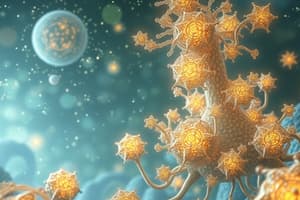Podcast
Questions and Answers
Which theory suggests that life may have originated from organic molecules delivered to Earth via meteorites or comets?
Which theory suggests that life may have originated from organic molecules delivered to Earth via meteorites or comets?
- Icy ocean theory
- Hydrothermal vent theory
- Panspermia theory (correct)
- Electric spark theory
How did the introduction of ice, carbon oxides, ammonia, methane, and hydrogen contribute to the origin of life on primitive Earth?
How did the introduction of ice, carbon oxides, ammonia, methane, and hydrogen contribute to the origin of life on primitive Earth?
- They provided essential elements for the formation of simple biomolecules (correct)
- They cooled the Earth's surface, stabilizing early organic compounds
- They increased volcanic activity, creating diverse habitats
- They formed an atmosphere, which protected early life forms from radiation
Which of the following describes a protocell featured within the text?
Which of the following describes a protocell featured within the text?
- A large, multi-cellular organism
- A simple single-celled organism with a nucleus
- A complex structure with advanced organelles
- A structure with small biomolecules inside (correct)
Why did the icy ocean theory gain prominence in discussions about the origin of life?
Why did the icy ocean theory gain prominence in discussions about the origin of life?
What is a key characteristic of the Earth during its early stages, according to the text?
What is a key characteristic of the Earth during its early stages, according to the text?
Flashcards
Electric Spark Theory
Electric Spark Theory
Life began with frequent lightning strikes on Earth, creating biomolecules.
Deep-Sea Vent Theory
Deep-Sea Vent Theory
Life arose from simple inorganic molecules at deep-sea hydrothermal vents, producing molecules of life.
Protocell
Protocell
Circular structure containing biomolecules, potentially the precursor to cells.
Ice Theory
Ice Theory
Signup and view all the flashcards
Panspermia Theory
Panspermia Theory
Signup and view all the flashcards
Study Notes
- Several origin-of-life theories exist, based on mathematical and fossil evidence.
Electric Spark Theory
- Life originated when frequent lightning strikes on Earth produced biomolecules.
Deep-Sea Hydrothermal Vents Theory
- Abiogenesis suggests life's molecules formed from simple inorganic molecules near deep-sea vents.
- Deep-sea vents emit hot gases and liquids that accumulate small molecules like hydrogen and minerals.
- Reactions, aided by catalysts, produced life's molecules within these vents.
- Scientists have replicated vent conditions to produce protocells.
Icy Oceans Theory
- Life may have started in oceans under ice, as amino acids are more stable at low temperatures.
- Cold environments could have facilitated the emergence of life.
Panspermia Theory
- Life may have reached Earth via meteorites or comets.
Early Earth Conditions
- Earth is about 4.6 billion years old.
- The universe began as a hot, dense point that exploded in the Big Bang.
- Particles from the Big Bang formed stars and planets, including Earth.
- Primitive Earth was bombarded by debris and lacked an atmosphere.
- Temperatures reached 10 billion degrees Fahrenheit (5.5 billion degrees Celsius).
- Volcanoes and meteor strikes further shaped Earth.
- Meteorites delivered ice, carbon oxides, ammonia, methane, and hydrogen.
- Chemical reactions at high temperatures led to the emergence of simple molecules about 3.7 billion years ago.
Oparin's Hypothesis
- Alexander Oparin theorized in 1924 that life arose from simple molecules in a low-oxygen atmosphere.
- Oparin suggested that the early atmosphere was reducing.
- The first life forms were heterotrophic and originated in the oceans.
- Early Earth lacked a protective atmosphere, leading to high ultraviolet radiation exposure.
- Oparin studied coacervates, which are collections of organic molecules in water with a lipid membrane.
- Coacervates are a type of protobiont, microspheres with a double-layered lipid membrane.
- Protobionts can maintain their internal environment.
- Oparin believed protobionts were precursors to living cells.
- His research showed biomolecules within coacervates function efficiently in metabolic processes.
- J.B.S. Haldane independently proposed similar ideas.
- Haldane suggested ultraviolet radiation helped form simple organic molecules that evolved into more complex ones.
Miller-Urey Experiment
- Stanley Miller and Harold Urey aimed to test Oparin's theory in 1953.
- They simulated Earth's early atmosphere in a glass apparatus with interconnected bulbs, pumps, and cooling systems.
- One bulb contained water to represent Earth's primordial soup.
- The other bulb held methane, hydrogen, ammonia, and water vapor, and was fitted with electrodes.
- Electric discharges simulated lightning and ultraviolet radiation.
- After a week, the water changed color, indicating a reaction has occurred.
- Analysis revealed that 15% of the methane converted to simple carbon compounds like formaldehyde and hydrogen cyanide.
- These compounds then formed more complex molecules, including the amino acids alanine and glycine.
- The experiment demonstrated that essential building blocks of life could evolve from simple molecules.
- The experiment supported Oparin's theory.
Studying That Suits You
Use AI to generate personalized quizzes and flashcards to suit your learning preferences.




